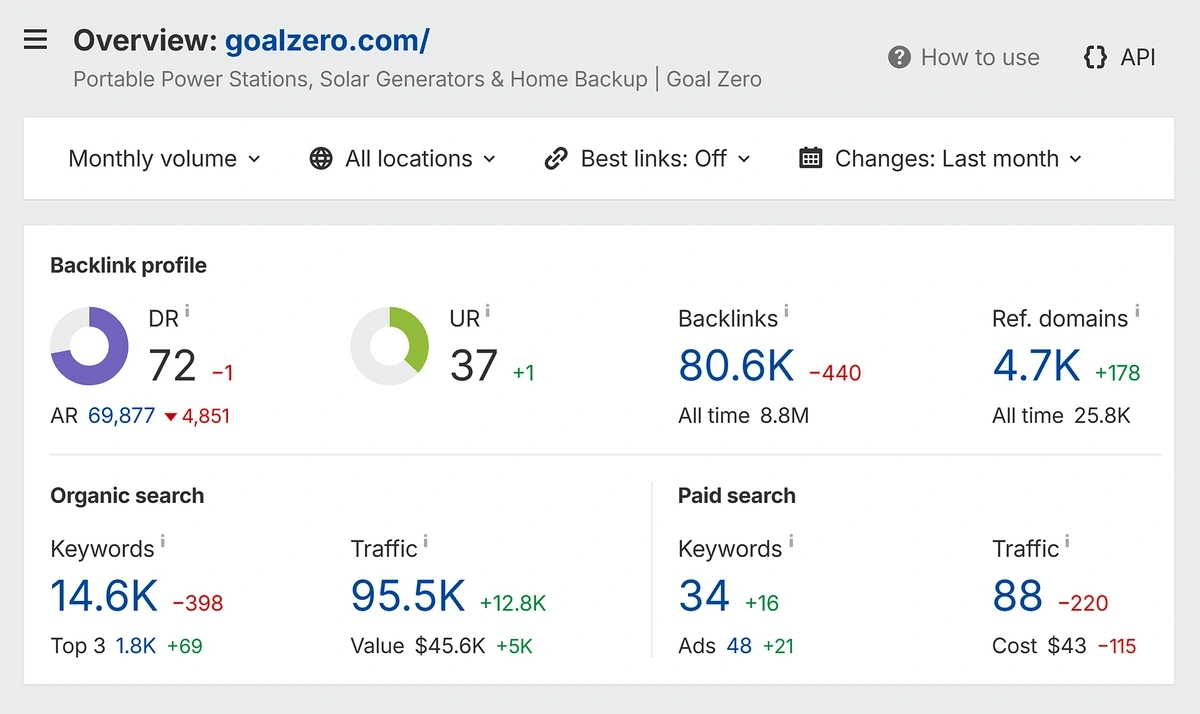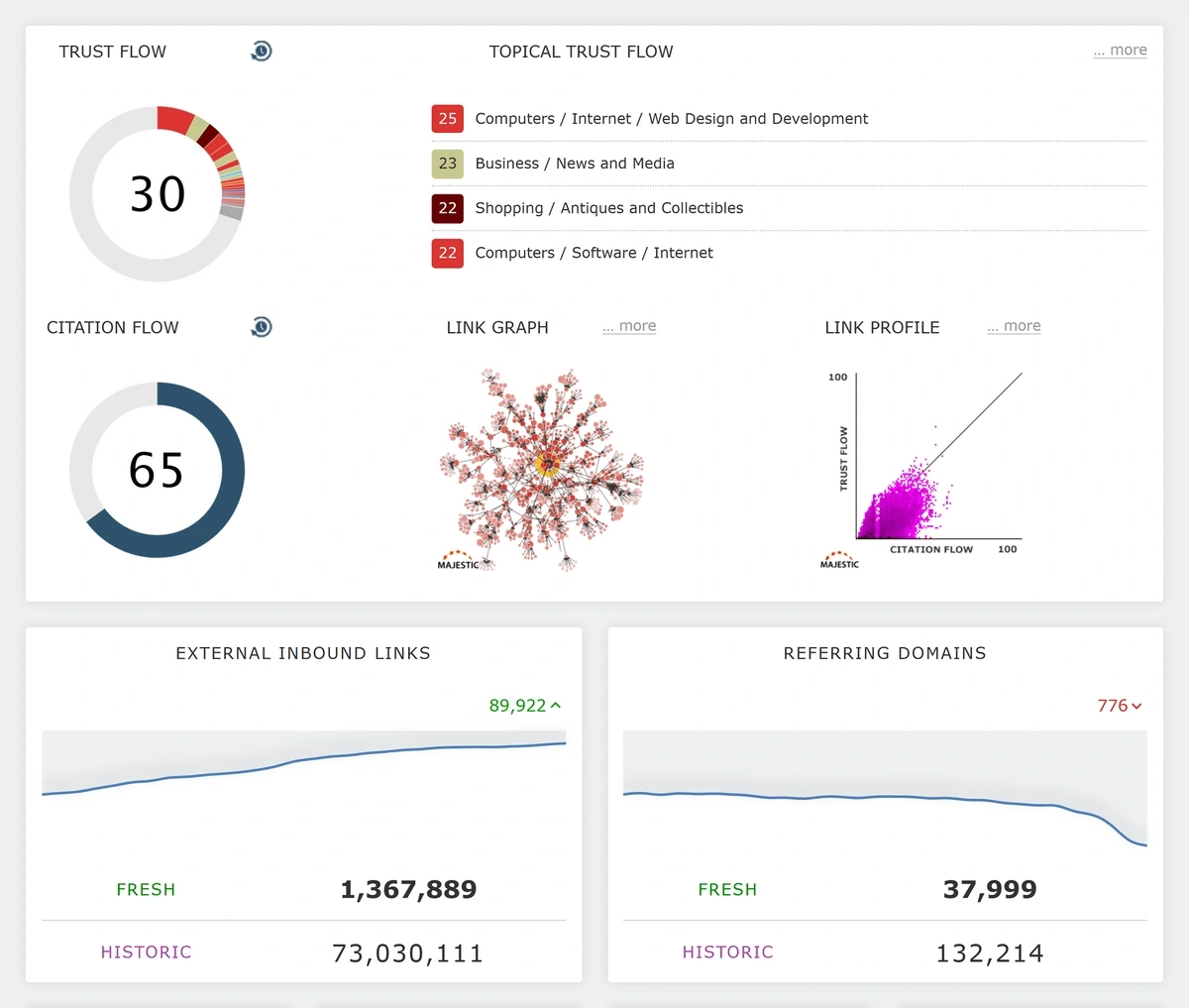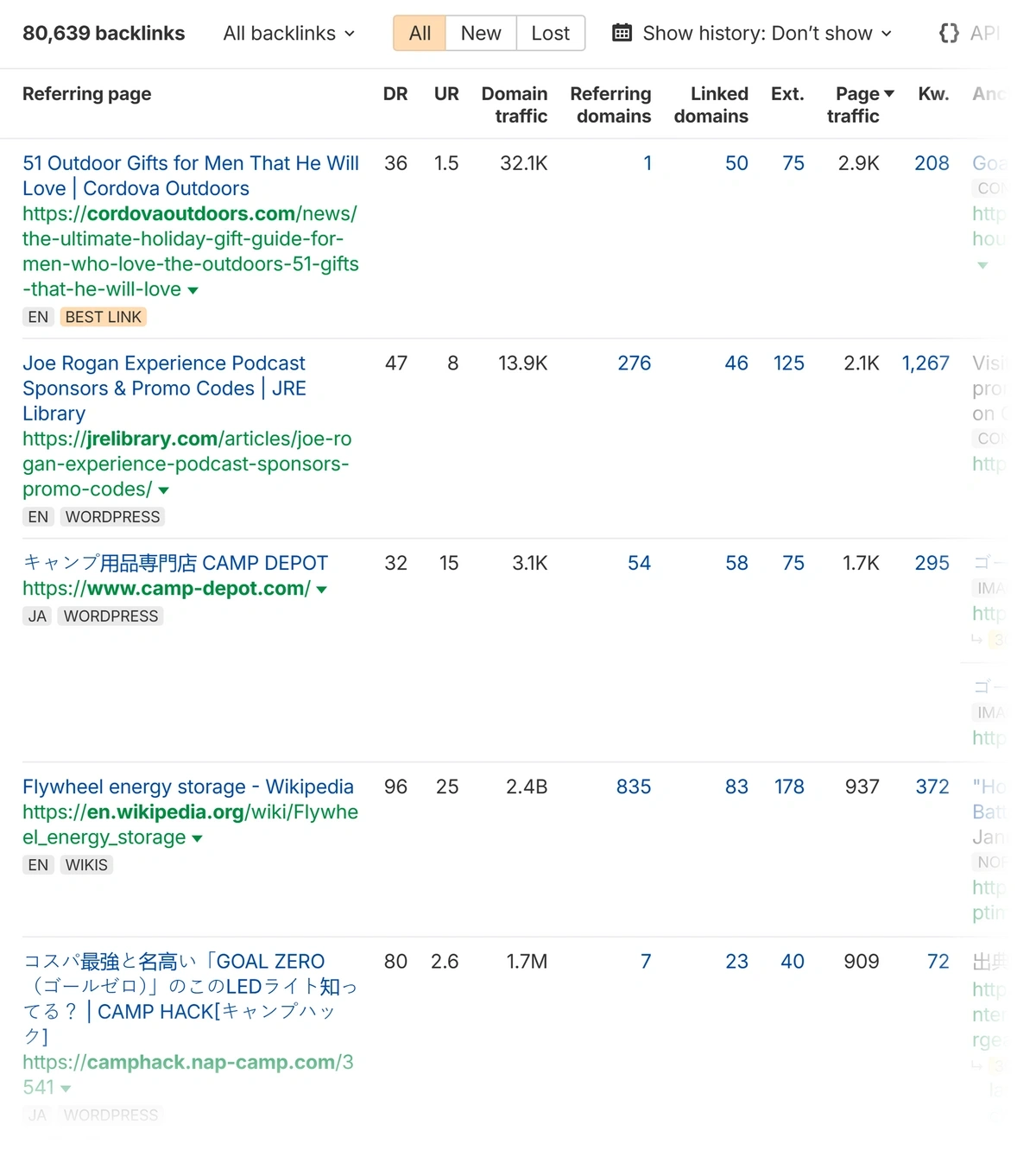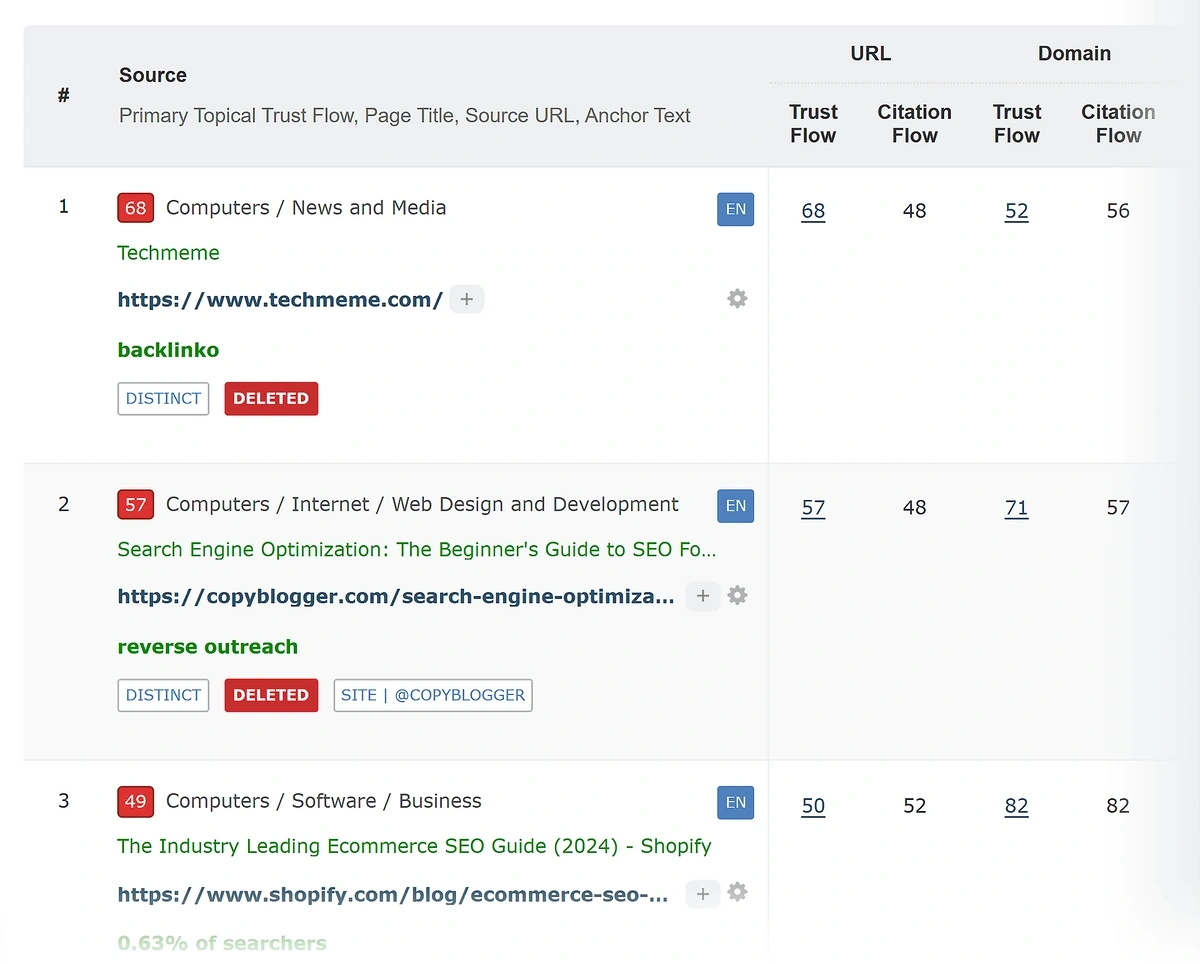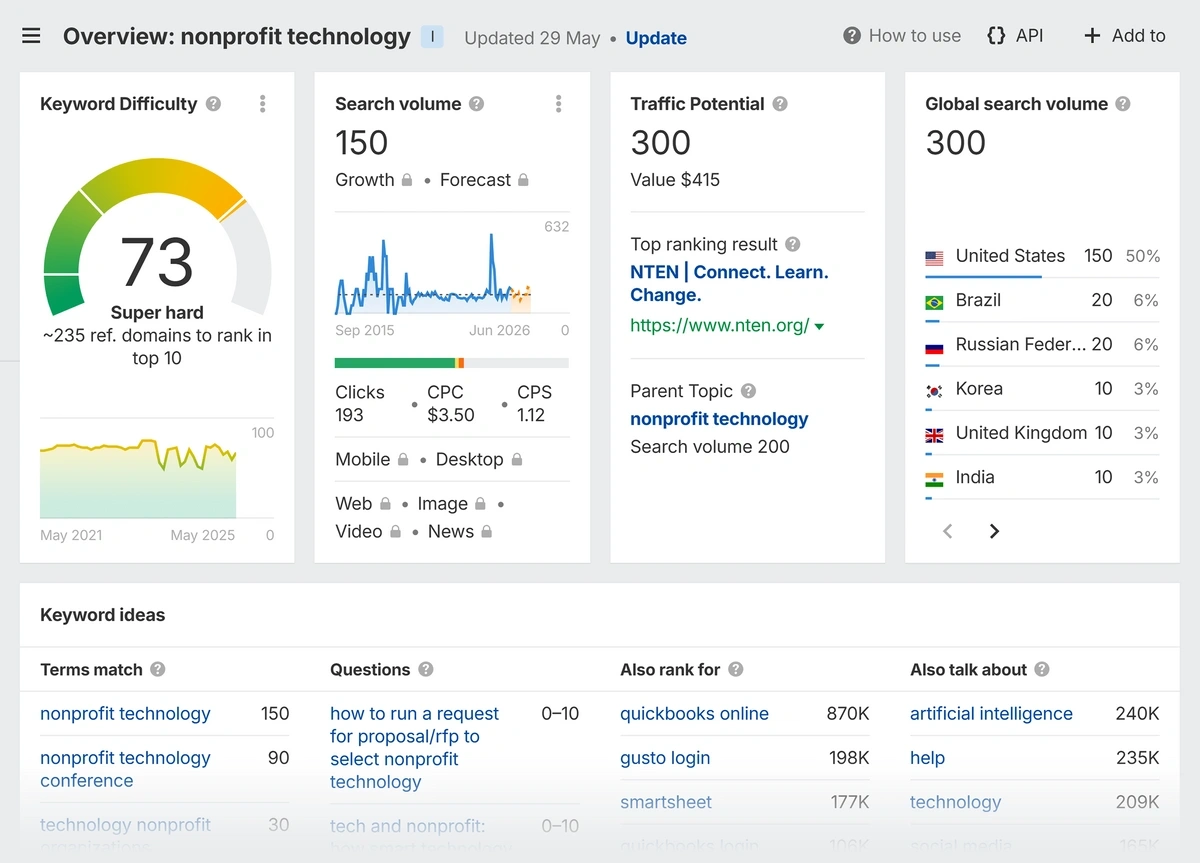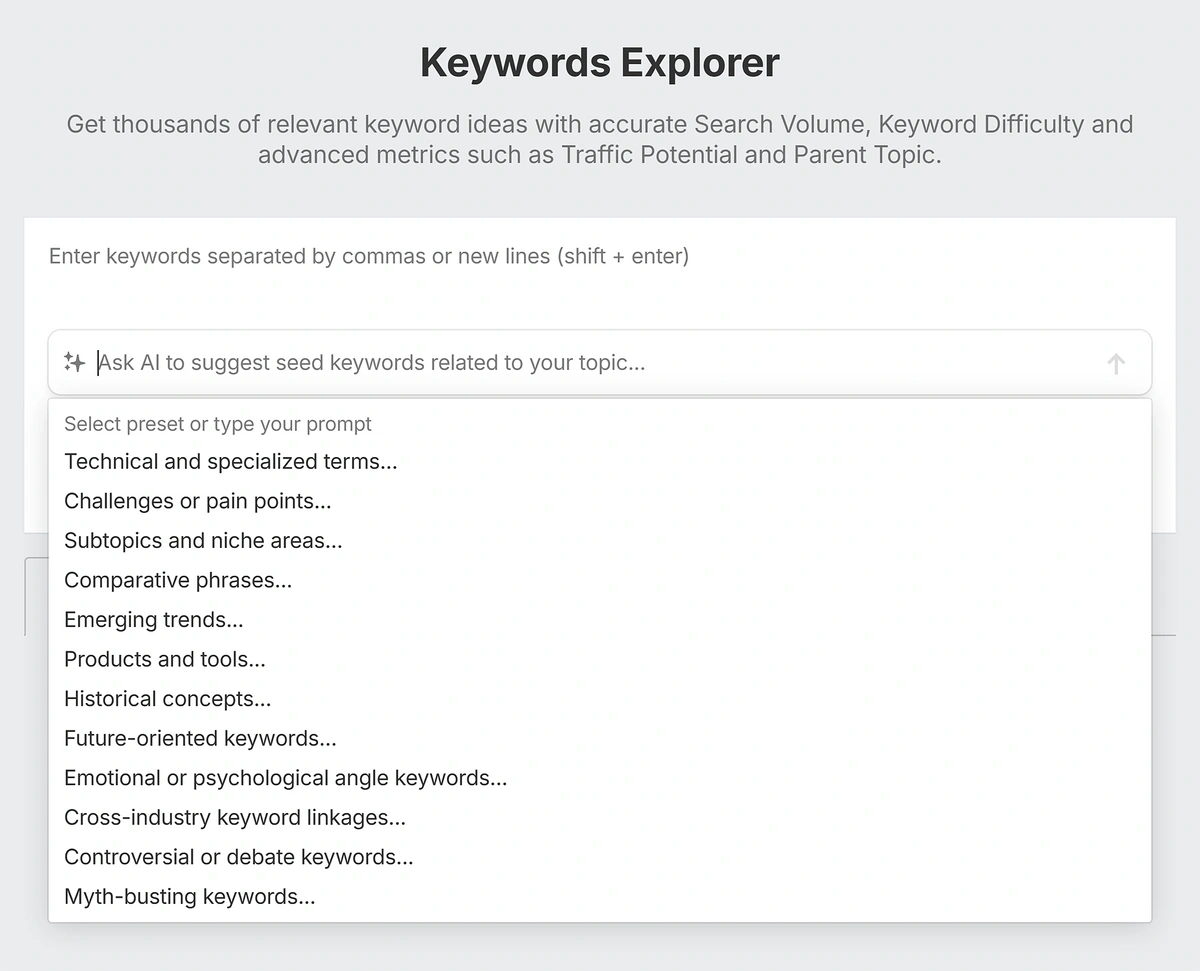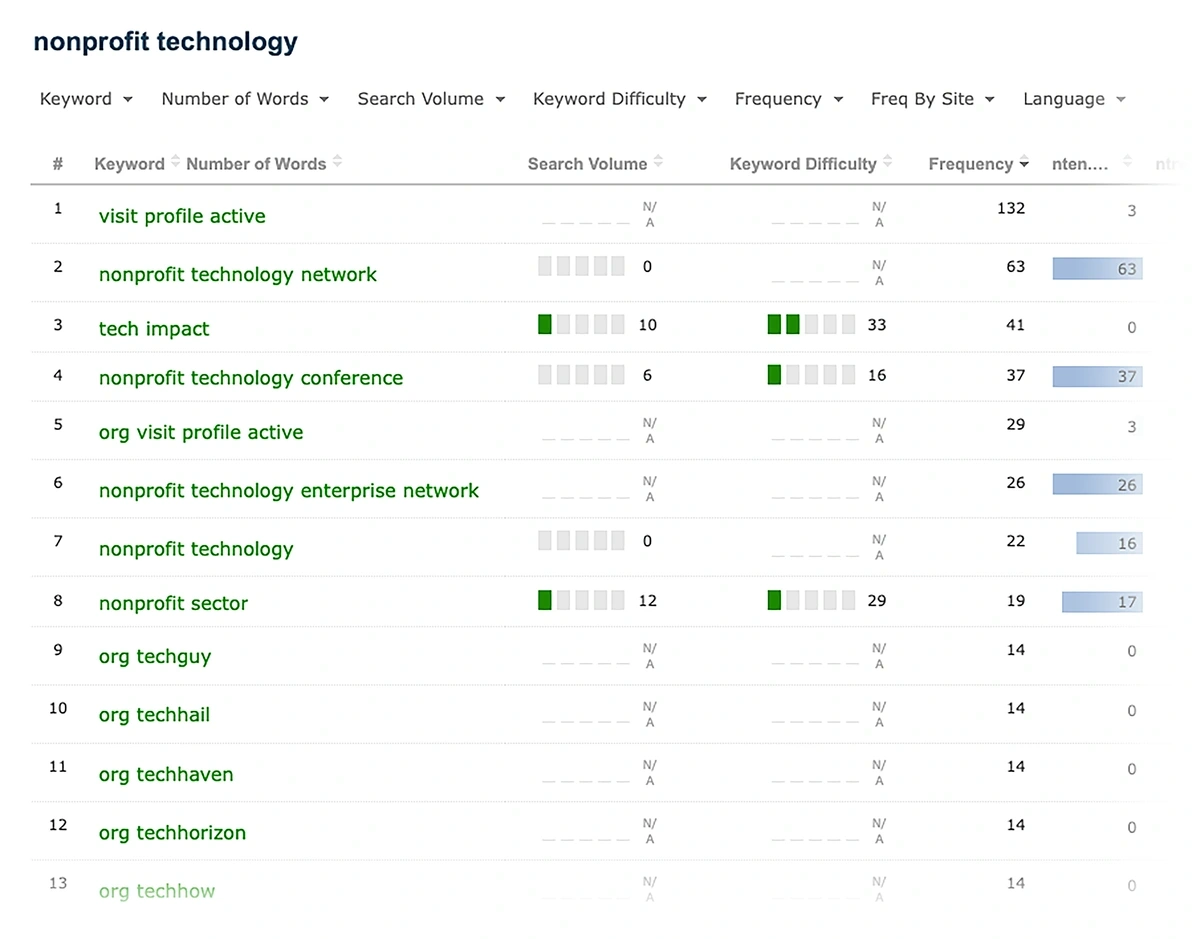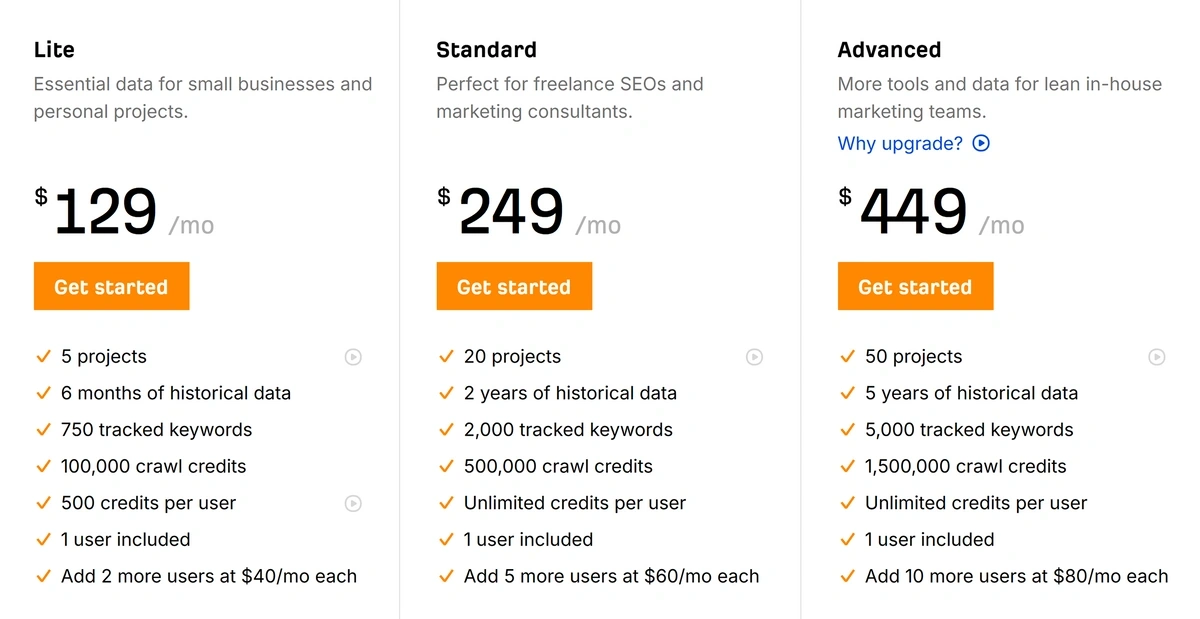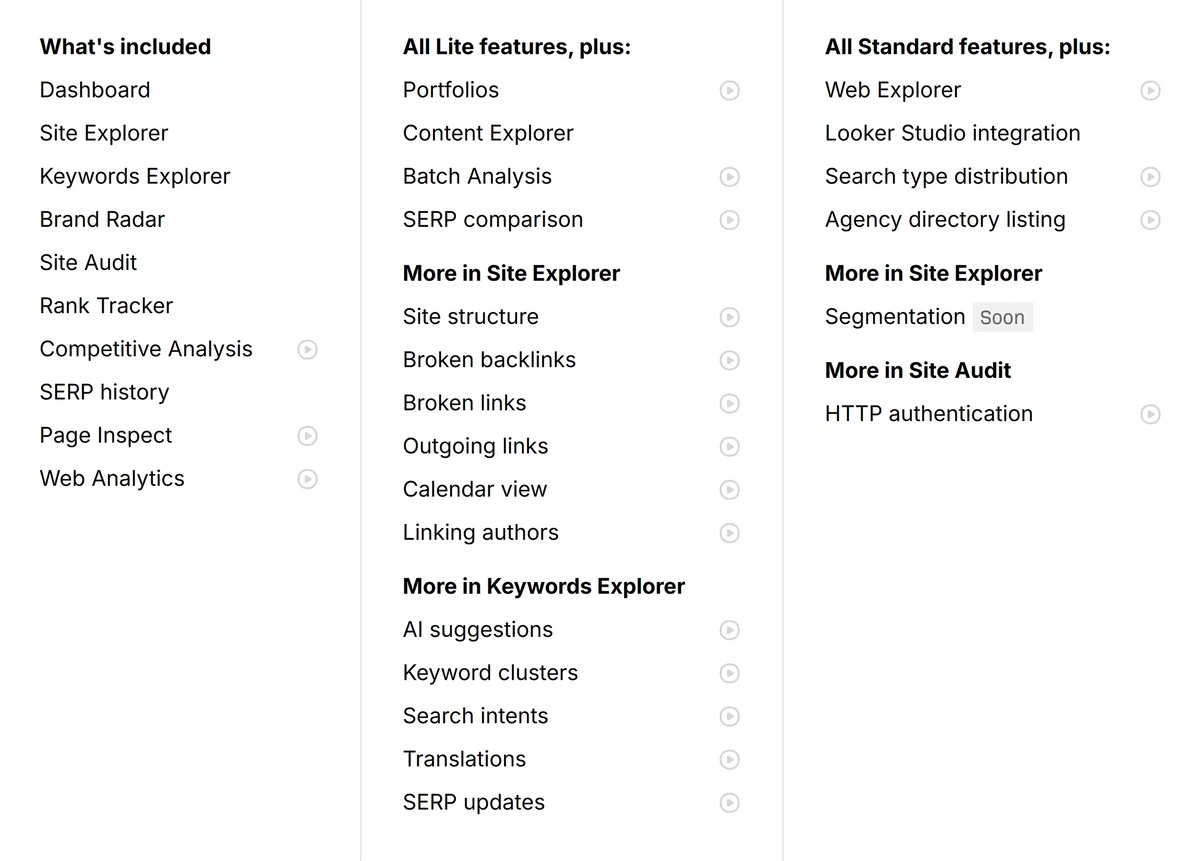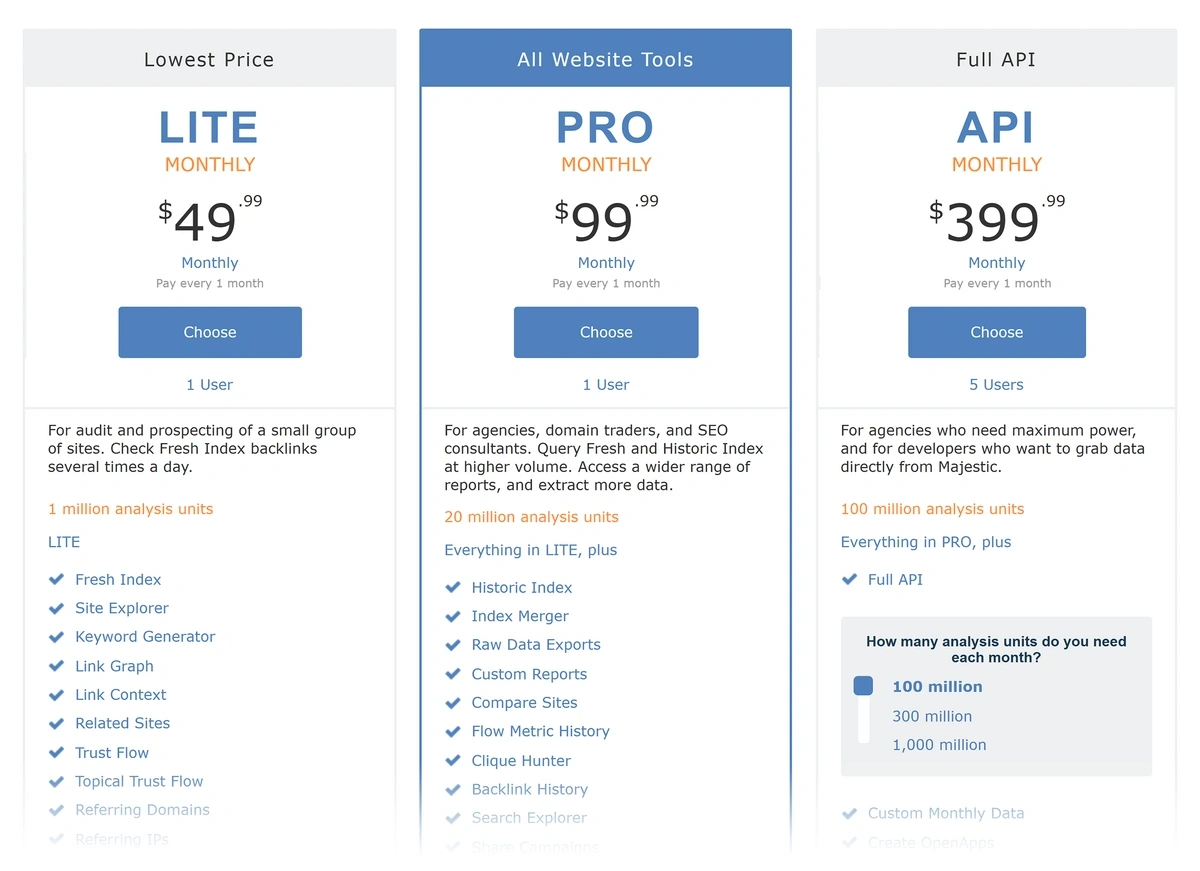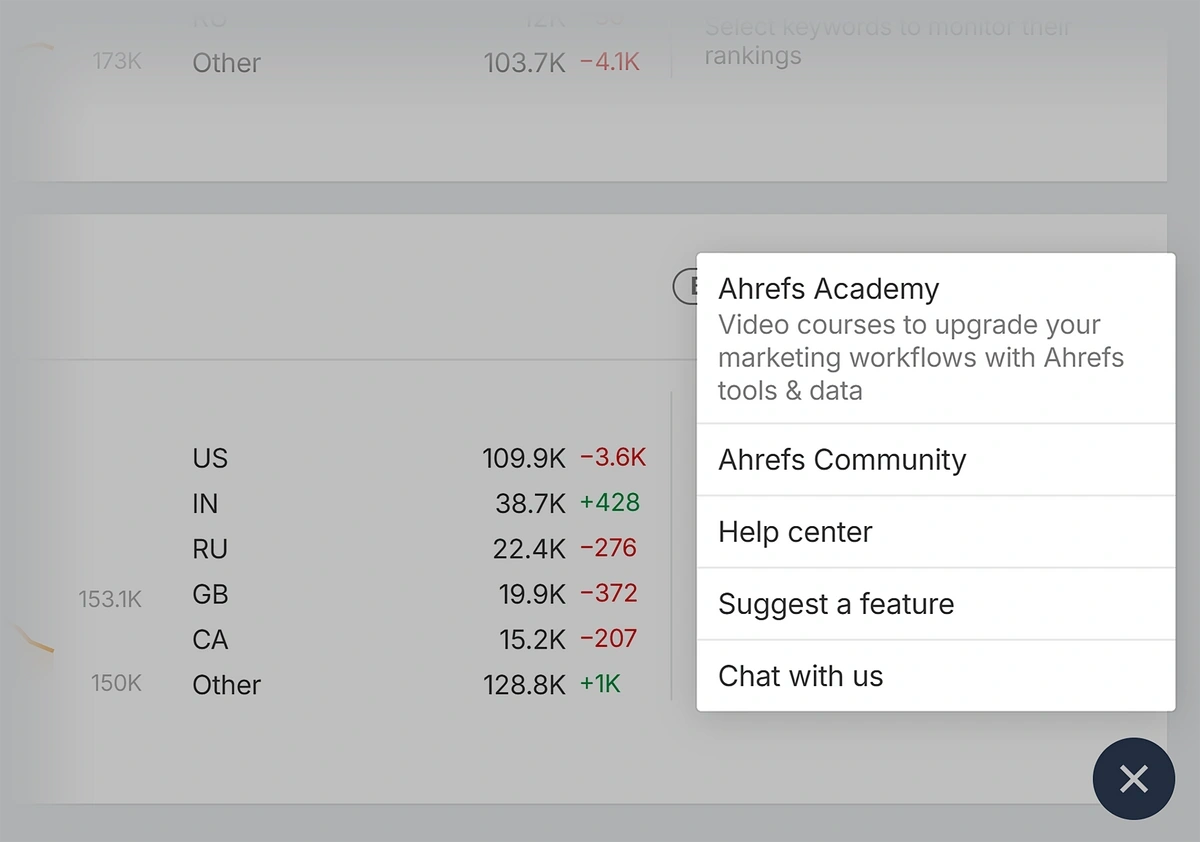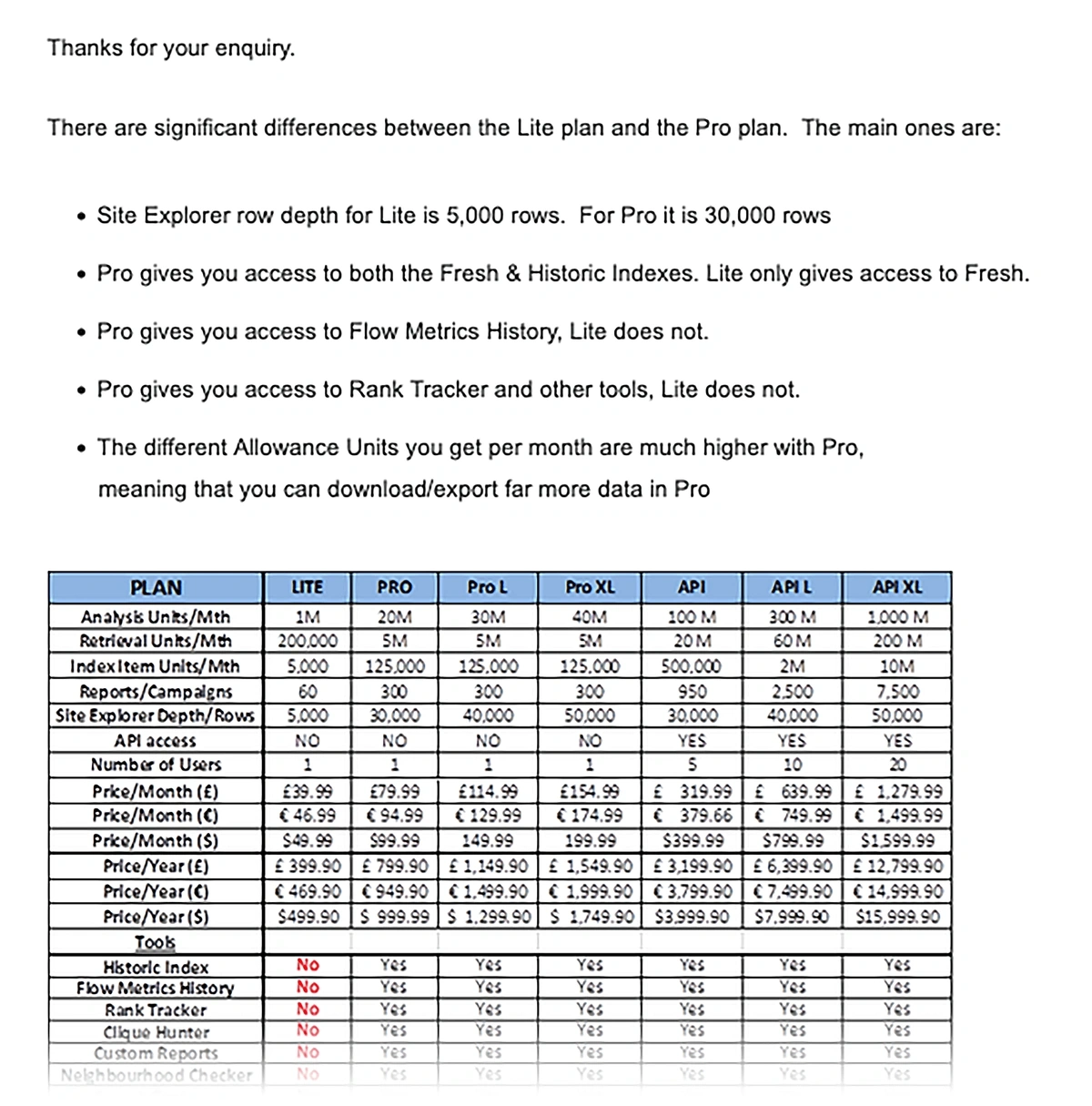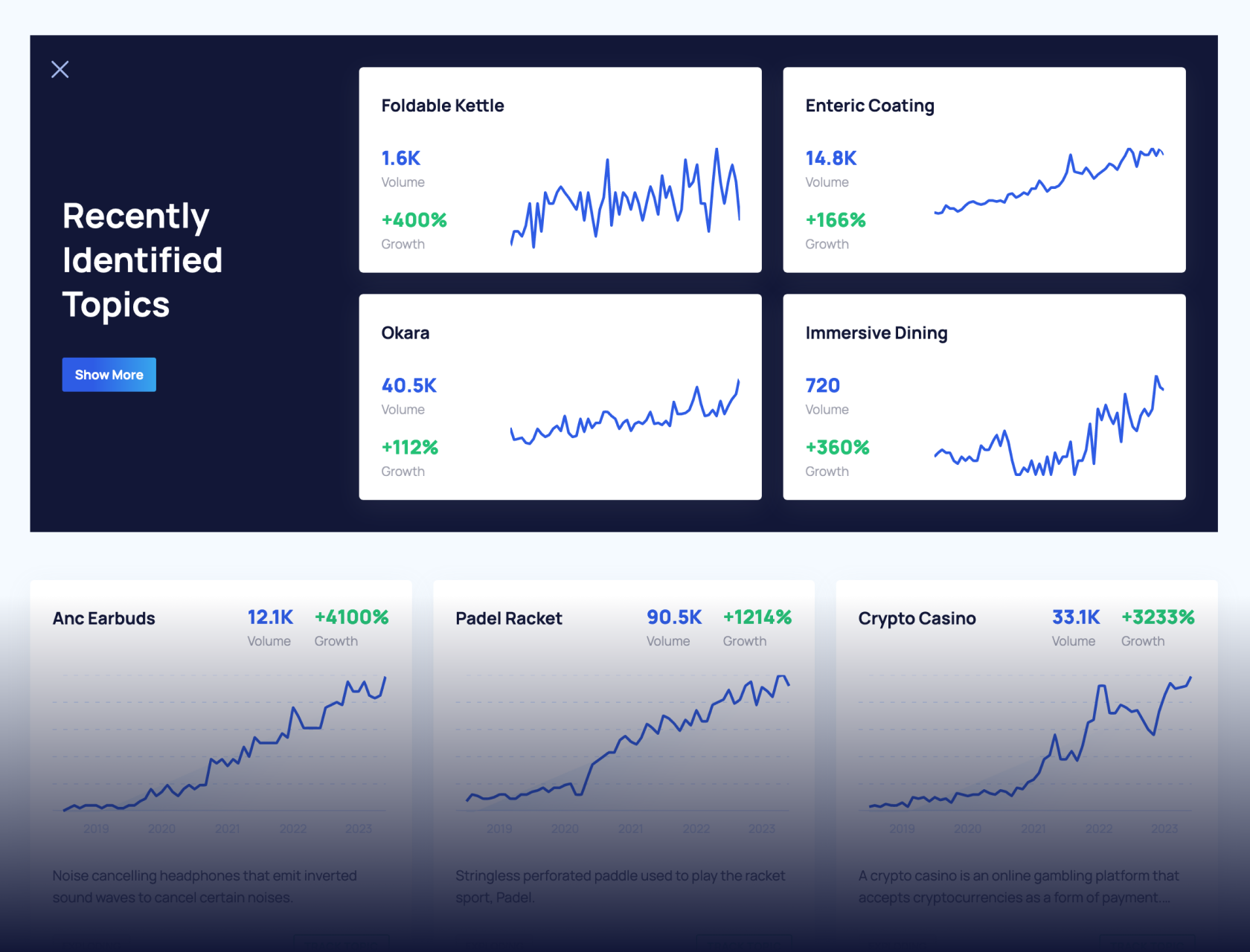
Ahrefs vs Majestic: My Thoughts After Testing Both
Ahrefs and Majestic are both well-known SEO tools that marketers use to optimize their content and add value for the audience. But how do they compare?
The main difference between Ahrefs and Majestic is that Ahrefs has more features to help you meet your site goals, while Majestic is most useful for link building.
Ahrefs vs Majestic at a Glance
| Ahrefs | Majestic | |
| Site Explorer | Robust and visually appealing. Easy filtering. | Dated visuals. Fewer and less intuitive filters. |
| Backlink Analysis | Extensive database to view backlinks with tools to analyze them. | Focuses on link context. Rows of data are limited by plan. |
| Keyword Research | Keywords Explorer offers various options for filtering, analysis, and management. | Very basic. Filter to find the most relevant suggestions. |
| Site Audits | Crawls your site at regular intervals to monitor site health. | No site audit capability. |
| Pricing | Starts at $29/month (Starter). | Starts at $41.67/month when paying annually (Lite). |
| Free Version? | Yes | Yes |
| Customer Support | Quick; AI-first | Slower; human response |
| Ease of Use | A bit complex, but tooltips and linked documentation help. | Simple, but tooltips are often confusing. No linked documentation. |
Comparing Site Explorer Tools
Ahrefs and Majestic both have Site Explorer features. The main differentiator is the depth of information available.
- Ahrefs offers a wealth of data in an intuitive format
- Majestic gathers much of its data, which is more limited, through less familiar, proprietary formulas
Want to Beat Your Competition?
Find out who’s linking to them and build a better backlink strategy.
Ahrefs’ Site Explorer
The Ahrefs Site Explorer lets you view backlink profiles and search traffic for any website or URL. After you enter that information, the Site Explorer dashboard displays an overview of backlink and search data. Below that, you’ll find numerous charts to filter and adjust to your specifications.
I like the way Ahrefs organizes data on this dashboard so that you can select a section from 4 options:
- General
- Backlink Profile
- Organic Search
- Paid Search
Then you can further drill down results using filters.
Good navigation made it easy for me to click among all the metrics and tabs to get a look at performance. With all the ways to filter and adjust the information, I could get the view I needed.
The side navigation menu includes even more options to explore. As a content marketer, the most interesting to me is Opportunities. It aggregates features for a quick way to view reports.
Some of the ones I’ve used most often are:
- Low-difficulty or low-competition keywords to assist with content updates
- Declining traffic to monitor content decay and lifecycles, and determine when it’s time to remove, merge, or update
- Potential cannibalization to understand potential keyword issues
- Descriptive anchors to help create clearer, less generic anchor text
If I have one slight hesitation, it’s just that the sheer volume of information—as well as the ways to filter it—can be overwhelming. For that reason, I sometimes use SEO tools like Ahrefs and Semrush together, just to make sure I’ve got my bases covered.
Ahrefs’ Site Explorer is a powerful tool. Whether you’re in SEO, content marketing, performance analytics, or any other role dealing with online content, you’ll never be lacking for data. Check out this Ahrefs review for a more detailed breakdown.
Majestic’s Site Explorer
There’s a visual display at the top of Majestic’s Site Explorer. It’s not as sleek as Ahrefs’, but it offers a visual representation of the data.
I expected that I’d be able to interact with this data the same way I can with Ahrefs or Semrush. I couldn’t click on numbers to go to reports or slide graphs around, however.
Link Graph and Link Profile let you open them to explore the data. They’re the only clickable items on the dashboard.
With a lot of SEO tools, if you get a feel for one, you can sort of make your way through others, as well. That’s not true of Majestic, largely because of proprietary metrics like Trust Flow and Citation Flow.
These aren’t terms I’d seen on other platforms. Fortunately, when you hover over metrics in the dashboard, tooltips provide definitions.
- Trust Flow is weighted by the number of links from a seed set of trusted sites to a given URL or domain
- Citation Flow is weighted by the number of citations to a given URL or domain
I’m still not completely sure what that means, so I don’t fully understand how it gives Majestic an edge.
What’s clear is that Majestic focuses more on link context, like:
- Where a link is located on a page
- What other links are around it
- Link density
- How links are distributed across a page
Link builders can benefit most from this context. As a content marketer trying to gauge overall performance to make decisions about my content, it doesn’t quite have everything else I need.
While I prefer Ahrefs in terms of the Site Explorer, I do think there’s a niche of link builders who could successfully figure out how to use Majestic’s proprietary metrics for positive outcomes.
Conducting a Backlink Analysis
Overall accessibility is the biggest factor to consider when comparing Ahrefs and Majestic. Both offer key backlink data that SEOs and marketers need. Majestic even has an impressive historic index that dates back to 2006. Ahrefs is just easier to navigate.
Backlink Analysis With Ahrefs
From Ahrefs’ Site Explorer, there’s a left sidebar menu with an item called Backlink Profile. This is what you need for a successful backlink analysis.
Just as it was with the Site Explorer, there are numerous ways to filter the data when you’re looking at the backlink profile.
- Dofollow
- Nofollow
- UGC/Sponsored
- Links settings
- Backlink type
- Domain rating within a date range
- Domain traffic with date range
- By word or phrase within a page, URL, or author profile
I wanted to see the total number of backlinks it would give me for a given site, and it showed 8,551,709 with no filters in place.
Ahrefs beats Majestic here, offering ample opportunities for SEOs to dig into those settings and strengthen the backlink profile.
My only criticism is that, again, its strength can be its weakness. All of the options and filtering abilities can get a little confusing.
This is another instance in which I often use Semrush and Ahrefs together. Compared to Ahrefs, Semrush is organized in a way that makes more sense to me.
Backlink Analysis With Majestic
Backlinks are where Majestic shines brightest.
From the Site Explorer, I saw the number of backlinks for the test site was 17,722,241. Recall that Ahrefs told me 8,551,709. I’d heard that Majestic has a tendency to inflate backlink numbers, and this appears to be true.
As I mentioned, you can’t click on numbers in Majestic’s Site Explorer, so I looked in the side navigation for a backlink analysis option. There wasn’t one.
Under the free tools, I found a backlink checker, so I tried that. After typing in the URL, it took me right back to the Site Explorer with the numbers I couldn’t click. This is poor, confusing navigation.
There’s an option for Backlinks, so I clicked that. It took me to a results screen that seemed to show the backlinks I was looking for, and there were ways to filter them at the top.
Though there are a lot of ways to filter them, I couldn’t immediately find a way to sort out the broken links. That’s a big deal for SEOs.
On the Lite Plan, you get 5,000 rows of results. With the API plan, you get 50,000 rows. For a larger site, I’m not sure how you’d ever be able to see your complete backlink profile. On Ahrefs, I could go through 171,000+ pages of backlink results on the Starter plan.
The only additional information I was able to glean about the links was which were new and which were lost. Those are the only two additional Backlinks options.
There’s also a nav menu option called Context that deals with links. Its purpose is to help the user find more information about their links, including where and how they exist, and their relevance and quality.
Get More Search Traffic
Use trending keywords to create content your audience craves.
Conducting Keyword Research
The main difference between Ahrefs and Majestic when it comes to keyword research is that Ahrefs’ Keyword Explorer is far more comprehensive than Majestic’s Keyword Generator. Ahrefs gives you more data to do deeper research, whereas Majestic only generates keywords.
Keyword Research With Ahrefs
You have a few options when researching with the Ahrefs Keyword Explorer tool.
- Add seed keywords to get ideas
- Upload a bulk keyword file to get all the data at once
- Create keyword lists to monitor performance
- Ask the AI tool to suggest related seed keywords for your topic
- Browse the entire database to see top searches
First, I tested it with the “nonprofit technology” keyword.
I got a well-organized dashboard with a high-level view of what it will take to rank for that keyword, along with 124 keyword ideas.
Not only will it offer keyword suggestions, but it will also offer questions to consider and additional topics to talk about with that keyword. This is the keyword research tool you need if you want to reach your target audience.
With the AI tool, you enter your topic and choose a preset or prompt depending on your needs.
The presets make it foolproof. This is a fantastic tool for keyword research and idea generation in general.
Additional data available on Keyword Explorer includes:
- Intent
- Keyword difficulty
- Search volume
- Growth rate
- Device distribution
- Global search volume
- Traffic potential
- Global traffic potential
- Cost Per Click (CPC)
- Cost Per Search (CPS)
- Parent topic
- SERP features (includes AIO)
In addition to those filters, there are preset options grouped by:
- Use cases
- User lifecycle
- Audience
- Keyword modifiers
- Product
These presets simplify keyword research and performance monitoring, especially for those who haven’t yet mastered highly customized reports. You can also create and save your own presets.
This barely scratches the surface of everything Ahrefs’ Keyword Explorer can do. If you’re serious about keyword research, this is the tool.
Keyword Research With Majestic
Majestic’s keyword research is limited to a basic keyword generator. Though it exists, it also feels a bit like an afterthought. It provides some additional information, but Ahrefs outclasses it in every way.
To compare, I typed in the same seed keyword that I used when I tested Ahrefs. Where Ahrefs gave me 124 results, Majestic gave me 210, but many seemed questionable or unrelated. There were more “N/A” scores than metrics.
I used filters to remove all of the N/A results from the search volume and keyword difficulty fields, taking it down to 51 results.
Majestic allows you to filter by:
- Keyword
- Number of words
- Search volume
- Keyword difficulty
- Frequency
- Frequency by site
- Language
A glaring omission is search intent data, which is standard in Ahrefs, Semrush, and most other common SEO platforms.
It has far less functionality and fewer options than Ahrefs, but it’s still possible to narrow down a targeted list. If you only need to do surface-level research, this would do the trick.
If you’re not quite ready for Ahrefs, but you want to do deeper keyword research, give the Semrush Keyword Research Tool a look. I like the AI-powered Personal Keyword Difficulty scores that give me a better idea of my chances of ranking.
Conducting a Site Audit in Ahrefs
If you’re between Ahrefs and Majestic and you’re planning to conduct site audits, Ahrefs is the only choice. Majestic doesn’t currently offer site audits.
Ahrefs’ Site Audit tool crawls your site at regular intervals. This helps you monitor site health and quickly identify issues that arise.
As part of the Site Audit tool, you can generate the following reports:
- URLs crawled
- Health score
- Total issues
Ahrefs also lets you connect to Looker Studio and add site audit data to your reports there.
Pricing
Ahrefs and Majestic both offer a limited free option. You can get started with Ahrefs on the Starter Plan for $29/month. Majestic Lite costs $41.67/month with an annual subscription. Both platforms offer multiple plan tiers with more features and functionality.
Ahrefs Pricing
Ahrefs Webmaster Tools is free for sites with verified ownership. With it, you’ll get:
It’s obviously not as robust as the full version, but still packs a powerful punch for a free version. It’s a low-risk way for site owners to learn their way around Ahrefs.
Though you can collect quite a bit of site data, access is still limited. For example, the free version doesn’t include access to Keyword Explorer or Rank Tracker. And because there’s no ability to view information for sites you don’t own, it doesn’t offer much in the way of competitor research.
If you want access to more features and data, don’t miss the Ahrefs Starter plan for $29/month.
This is the way to go if you want to get more experience with the tools. It’s also a good option for smaller sites and light users who need more than the free version, but not as much as the tiered plans.
Businesses and larger sites will, of course, want more data and features. For that, Ahrefs offers three tiers: Lite, Standard, and Advanced.
As you’d expect, features increase with the tiers.
An Enterprise plan is also available for $1499/month.
Majestic Pricing
Majestic has a free plan, but it’s extremely restricted. Trying to get a feel for Majestic, I hit the limit pretty quickly. I returned the next morning to discover the limits weren’t lifted. When they say come back tomorrow, they mean a full 24 hours later.
If you want to try Majestic, bypass the free plan altogether and sign up for Lite for $49.99/month. There’s a 7-day money-back guarantee. You’ll have a week to try it out, risk-free.
Although the Ahrefs Starter Plan is an objectively better tool, the price is right on Majestic, especially if you’re an SEO doing link building on a budget.
Using Customer Support
The main difference between Ahrefs and Majestic when it comes to customer support is that Ahrefs is a quick AI-first response, while Majestic is a slower, human response.
Accessing Ahrefs Customer Support
To put the customer support experience to the test, I reached out to Ahrefs looking for some new user tips.
There’s a question mark icon in the lower-right corner. Clicking it opens a help menu.
I wanted to test out the chat feature, so that’s what I chose.
Within a minute of sending my question, I received a response.
On one hand, the AI response gives sound advice about steps to take for success with the platform. On the other hand, it feels a bit impersonal. I was hoping to get more personalized tips.
Accessing Majestic Customer Support
I accessed Majestic customer support from the dropdown menu under My Account in the top right of my dashboard.
I was feeling pretty confused about the line limits on data and how that might impact use of the full historic index, which is actually one of Majestic’s best features. That seemed like a good question for support.
By the time I sent my question, Majestic’s support hours, which run from 8 a.m. to 6 p.m. in the UK, were over. I received a response about eight hours later.
The response was from a real human, which I appreciate. Unfortunately, I didn’t feel like it answered my question.
Ease of Use
In terms of ease of use, the most significant difference between Ahrefs and Majestic is how many opportunities they provide for guidance and learning.
- Ahrefs links to documentation in the tooltips and includes videos for more context
- Majestic has tooltips, but they’re often confusing
Ease of Use: Ahrefs
Ahrefs isn’t difficult to use, but all the options and filters can make it easy to get lost. That said, they do a better job of product education throughout, making learning part of the journey.
Visualizations and data are presented clearly. Simple, modern designs make them easy to follow.
Tooltips aren’t always obvious, but you can hover over just about anything for a quick definition or explanation. This was often enough clarification for me, but there are also links included for further learning.
Navigation is well organized throughout menus and tabs.
I’ve used Ahrefs in the past and find it to be well suited to my needs with a smaller site and fewer reasons to run metrics daily. It’s just a fantastic tool, whether you’re monitoring site KPIs, informing your content strategy, or improving your SEO.
Ease of Use: Majestic
Majestic should be easy to use in theory since it’s a pretty basic tool, but it still feels confusing.
- Visualizations aren’t nearly as slick. They’re present, but they look outdated by comparison, and there are fewer to compare.
- Tooltips are present on a lot of the headings, but you have to find them by chance. The definitions and descriptions don’t always feel like someone wrote them with the end user in mind.
The biggest reason Majestic was difficult for me to use is because its proprietary metrics make it feel unfamiliar. Experience with other platforms won’t necessarily translate to Majestic.
How to Choose the Best SEO Analytics Platform
SEO platforms always cover the same basics well. My suggestion is to look at the niche tools you need and see which one covers those best.
These are my thoughts:
| What I Like About Ahrefs | What I Don’t Like About Ahrefs |
| Depth of data and features | All the tools can be a little overwhelming when you’re first starting out |
| Keyword research tool | Data is taken from Google only |
| Product education is easy to access | AI-first customer support |
| What I Like About Majestic | What I Don’t Like About Majestic |
| Historic index going back to 2006 | Dated look |
| Fewer options make it easier to focus on what you need | Limited scope of data |
| Human customer support | Keyword tool is too basic for long term use |
If you’re focused on link building and want the benefit of a massive historic index, Majestic is worth a look. If you’re doing keyword research and analysis, Ahrefs is going to be a better option.
Majestic isn’t going to show you broken backlinks. Ahrefs isn’t going to show you traffic data apart from Google. If the flaws get in the way of meeting your goals, there are plenty of other SEO tools out there. For instance, you can read our Ahrefs vs SpyFu review here.
You can even use more than one at a time. I mentioned I do that with Ahrefs and Semrush.
Semrush isn’t cheap, but there’s so much value in all its additional features. It offers intuitive navigation and comprehensive reporting that’s easier to manage than complex filters.
Want to give it a try? Learn how you can try Semrush free for 14 days.
Stop Guessing, Start Growing 🚀
Use real-time topic data to create content that resonates and brings results.
Exploding Topics is owned by Semrush. Our mission is to provide accurate data and expert insights on emerging trends. Unless otherwise noted, this page’s content was written by either an employee or a paid contractor of Semrush Inc.
Share
Newsletter Signup
By clicking “Subscribe” you agree to Semrush Privacy Policy and consent to Semrush using your contact data for newsletter purposes
Written By
Renee helps brands create and manage content that is strategic, engaging, and built to perform. With experience in content marketi... Read more
